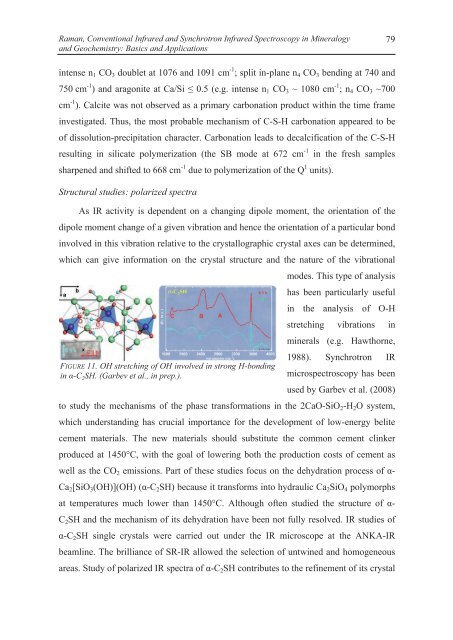instrumental techniques applied to mineralogy and geochemistry
instrumental techniques applied to mineralogy and geochemistry
instrumental techniques applied to mineralogy and geochemistry
Create successful ePaper yourself
Turn your PDF publications into a flip-book with our unique Google optimized e-Paper software.
Raman, Conventional Infrared <strong>and</strong> Synchrotron Infrared Spectroscopy in Mineralogy<br />
<strong>and</strong> Geochemistry: Basics <strong>and</strong> Applications<br />
79<br />
intense n 1 CO 3 doublet at 1076 <strong>and</strong> 1091 cm -1 ; split in-plane n 4 CO 3 bending at 740 <strong>and</strong><br />
750 cm -1 ) <strong>and</strong> aragonite at Ca/Si 0.5 (e.g. intense n 1 CO 3 ~ 1080 cm -1 ; n 4 CO 3 ~700<br />
cm -1 ). Calcite was not observed as a primary carbonation product within the time frame<br />
investigated. Thus, the most probable mechanism of C-S-H carbonation appeared <strong>to</strong> be<br />
of dissolution-precipitation character. Carbonation leads <strong>to</strong> decalcification of the C-S-H<br />
resulting in silicate polymerization (the SB mode at 672 cm -1 in the fresh samples<br />
sharpened <strong>and</strong> shifted <strong>to</strong> 668 cm -1 due <strong>to</strong> polymerization of the Q 1 units).<br />
Structural studies: polarized spectra<br />
As IR activity is dependent on a changing dipole moment, the orientation of the<br />
dipole moment change of a given vibration <strong>and</strong> hence the orientation of a particular bond<br />
involved in this vibration relative <strong>to</strong> the crystallographic crystal axes can be determined,<br />
which can give information on the crystal structure <strong>and</strong> the nature of the vibrational<br />
modes. This type of analysis<br />
has been particularly useful<br />
in the analysis of O-H<br />
stretching vibrations in<br />
minerals (e.g. Hawthorne,<br />
1988). Synchrotron IR<br />
FIGURE 11. OH stretching of OH involved in strong H-bonding<br />
in -C 2 SH. (Garbev et al., in prep.).<br />
microspectroscopy has been<br />
used by Garbev et al. (2008)<br />
<strong>to</strong> study the mechanisms of the phase transformations in the 2CaO-SiO 2 -H 2 O system,<br />
which underst<strong>and</strong>ing has crucial importance for the development of low-energy belite<br />
cement materials. The new materials should substitute the common cement clinker<br />
produced at 1450°C, with the goal of lowering both the production costs of cement as<br />
well as the CO 2 emissions. Part of these studies focus on the dehydration process of -<br />
Ca 2 [SiO 3 (OH)](OH) (-C 2 SH) because it transforms in<strong>to</strong> hydraulic Ca 2 SiO 4 polymorphs<br />
at temperatures much lower than 1450°C. Although often studied the structure of -<br />
C 2 SH <strong>and</strong> the mechanism of its dehydration have been not fully resolved. IR studies of<br />
-C 2 SH single crystals were carried out under the IR microscope at the ANKA-IR<br />
beamline. The brilliance of SR-IR allowed the selection of untwined <strong>and</strong> homogeneous<br />
areas. Study of polarized IR spectra of -C 2 SH contributes <strong>to</strong> the refinement of its crystal













